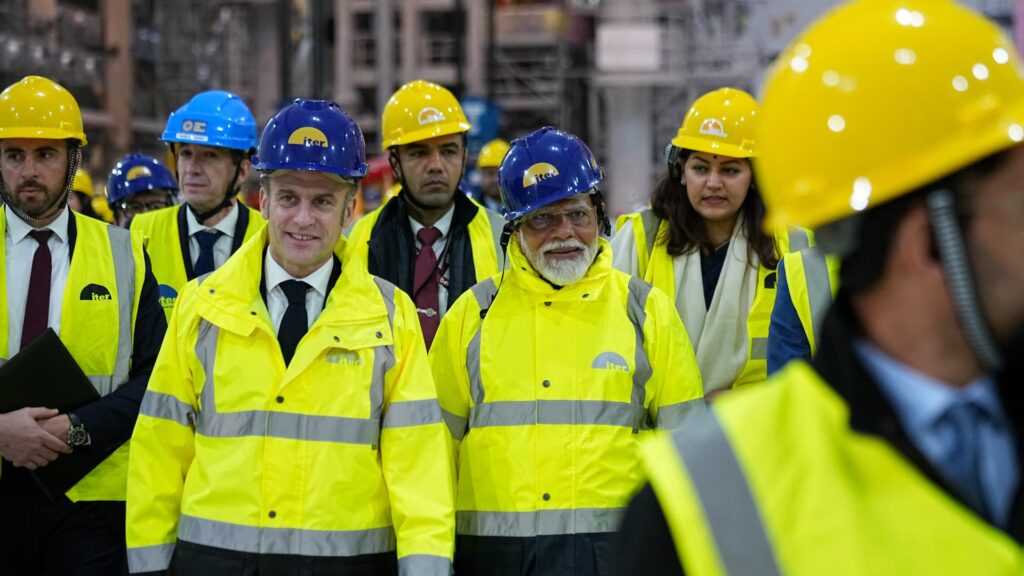This report is from this week’s CNBC’s “Inside India” newsletter which brings you timely, insightful news and market commentary on the emerging powerhouse and the big businesses behind its meteoric rise. Like what you see? You can subscribe here.
Saint-Paul-lez-Durance is a small town of about 1,000 people in the south of France, featuring a picturesque 15th-century château and a handful of shops.
Yet, its quaint charms were not the only reason that attracted Indian Prime Minister Narendra Modi this week. Saint-Paul-lez-Durance is also home to Cadarache, one of the world’s preeminent centers of nuclear research.
The thermonuclear visit comes after Finance Minister Nirmala Sitharaman set aside $2.3 billion in the federal budget earlier this month to promote the development of nuclear power generation in India.
“This initiative aims to enhance domestic nuclear capabilities, promote private sector participation, and accelerate the deployment of advanced nuclear technologies such as Small Modular Reactors (SMRs),” the government said in a statement.
Small modular reactors, that produce under 300 megawatts of electricity, have been touted as the answer to several challenges the nuclear industry faces. The industry says SMRs, which will be manufactured in modules elsewhere and assembled onsite, will reduce construction time and cost, which have tended to come in multiple times the initial estimates.
In fact, the government says it will build five modular reactors in under a decade using the funds, helping it reach its self-imposed 100-gigawatt nuclear energy target by 2047. Nuclear energy accounts for about 3% of India’s generation capacity currently, with plans to increase capacity from 6.7 gigawatts to 22.4 gigawatts by 2031.
While the goals are certainly ambitious, the challenges look daunting, if not outright impossible to overcome. The International Energy Agency and investment banks Bernstein and Royal Bank of Canada, for instance, say India’s nuclear ambitions are quite simply unachievable.
Even with China’s track record for infrastructure development, it took the country about 15 years to set up its first modular reactor Linglong One. Analysts say it will be “pleasantly surprising” if India were to beat this time scale.
“While it absolutely merits a whole-hearted attempt on India’s part – from a stock market analyst perspective it is too far to be … priced in today,” said Bernstein analyst Nikhil Nigania. “There is a low likelihood that even [one] indigenous SMR would be operational in India by 2033 against [the five the government] has planned.”
Atomic lawsuits
India may also have also stumbled on the first step.
A tender for a 220-megawatt Bharat Small Reactor, which isn’t modular, puts all the financial risks of building a nuclear power plant onto the private sector — under the “Civil Liability for Nuclear Damage Act” — while the state-owned power company NPCIL retains many of the benefits, including ownership and control of the power plant.
The CLND Act, which sees companies and their suppliers on the hook for any nuclear accident in India, is viewed by some industry experts as the bane of the private sector. They say if it were not for the law, construction of the world’s largest nuclear power plant would now be underway in India.
French-state-owned nuclear giant EDF, which operates more than 60 nuclear power stations in France and the U.K., submitted its plans in 2021 to build six reactor units that would generate 9.6 gigawatts of carbon-free energy. Yet, earlier this year, it said the existence of the CLND had prevented it from pushing ahead.
“In addition to the country risk, which includes a substantial tax dimension, the conditions related to the scope of nuclear liability in India must be met, and the project’s financing plan must be secured before the final contracts are signed,” EDF said in a bond prospectus document issued earlier this year.
U.S. nuclear giant Westinghouse Electric Company, meanwhile, proposed to build six 1,200 megawatt AP1000 reactors, which have been tried and tested in the U.S. as well as in China, more than a decade ago. Yet, no progress has been made on the deal since then.
“Westinghouse, the supplier of high output nuclear power plants, remains skittish about sales to India with the absence of durable assurance of limited liability in the event of an accident,” said Ashley Tellis, senior fellow at the Carnegie Endowment for International Peace in 2023.
The concerns have not gone unnoticed. The Indian government has said it intends to amend the laws preventing companies like EDF from entering the nuclear sector.
“For an active partnership with the private sector towards this goal, amendments to the Atomic Energy Act and the Civil Liability for Nuclear Damage Act will be taken up,” said Finance Minister Sitharaman in the budget speech to Parliament.
Amending the statute books is just a first step for India, however, as it looks to make some headway in meeting its nuclear goals.
Scarce land
Another key factor holding up the construction of these rotund machines has been finding suitable land. Nuclear scares of the past, including the Fukushima nuclear disaster of 2011, have repeatedly been used by locals to protest against having plants built in their backyard.
The foundation stone for the 1.4 gigawatt Gorakhpur plant in the state of Haryana was laid in 2014, for instance, yet it is not expected to produce a single joule of energy until 2032 — 18 years later.
But India is also learning from its experience.
Since finding land — and seeking a myriad of approvals from stakeholders — is one of the most time-consuming processes, new plants currently in the planning stages are being deployed in a cluster of six giga-sized reactors.
Most of India’s existing plants are geographically dispersed and only have two or four reactors that have sub-gigawatt production capacity each. The government now has about 6.5 gigawatts worth of reactors currently under construction that are all extensions to existing nuclear power plants, which require fewer permissions.
Today’s long timelines don’t mean it’s always been this way. The country has previously built reactors within five years, simply by replicating known technologies on existing nuclear plant sizes.
The private companies
Private companies currently involved with nuclear power projects — limited to only the non-core elements of a reactor — are also helping make the construction process significantly more efficient.
For instance, earlier this month, engineering firm Larsen & Toubro delivered the steam generators that are expected to be installed at the Kaiga Atomic Power Station in the southern state of Karnataka ahead of schedule.
“L&T is committed to deliver 6-8 nos 700 MWe Steam Generators every year and for the success of 220 MWe Bharat Small Reactor (BSR) programme to ensure net-zero carbon emissions by 2070,” said Anil V Parab, senior executive vice president of L&T Heavy Engineering in a statement.
Another way to cut timelines, and increase the odds of achieving India’s ambitious goal, is to partner up with foreign entities, such as France’s EDF, for technological expertise, according to analysts.
Russia supplies the underlying technology for the vast majority of India’s nuclear plants, while France and the United States are leading operators of nuclear energy reactor fleets.
Would it come as any surprise if nuclear was on Modi’s agenda while visiting Paris and Washington this week?







